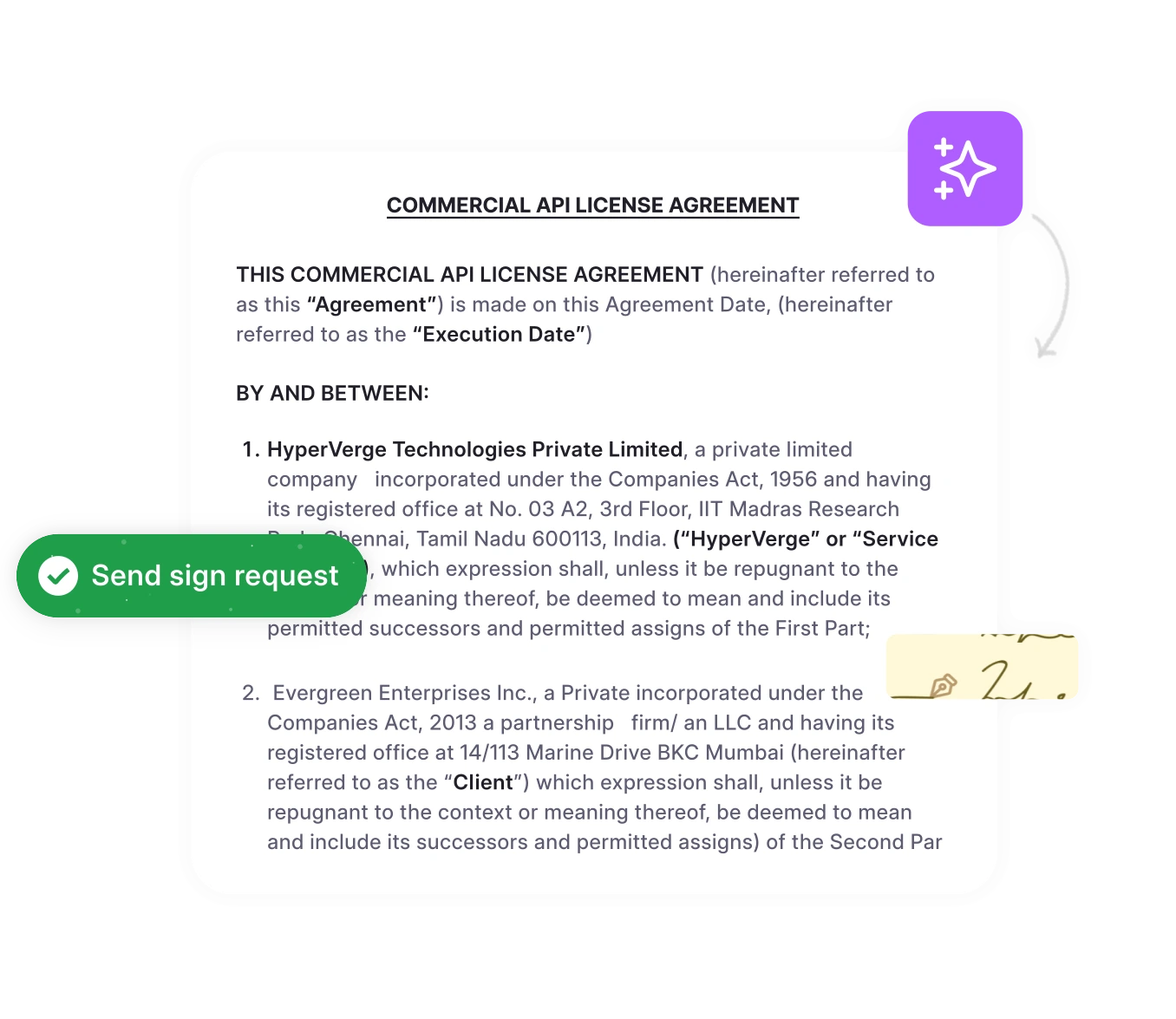The affiliate agreement is deceptively simple to draft but brutally complex to manage at scale.
You can pull a template off the shelf in five minutes. Sign up a handful of influencers by the end of the week. But six months in, when you’re juggling 47 active partners across eight states, each with different commission structures, payment schedules, and compliance requirements? That’s when the cracks show.
The affiliate marketing platform market alone reached $15.7 billion in 2023 and is projected to grow to $36.9 billion by 2030, which means the volume of agreements legal teams need to manage isn’t slowing down. And over 80% of brands now use affiliate programs to boost brand awareness and drive sales.
The real question isn’t whether you need an affiliate agreement template. It’s whether your current process can handle what’s coming next without creating compliance gaps, revenue leakage, or a bottleneck that stalls your marketing team for weeks.
“One strategic approach is aligning your affiliate program with broader business goals, such as targeting niche influencers for product adoption. This ensures partnerships drive measurable growth, like user acquisition, by focusing on high-ROI affiliates. It prevents dilution of efforts and maximizes scalability in competitive markets.”
Beyond the template: Defining the affiliate relationship
An affiliate agreement is the legally binding contract that governs how your company and an affiliate partner work together. Think of it as the operational rulebook that defines compensation models, promotional guidelines, intellectual property rights, and, crucially, what happens when things go wrong.
But here’s what makes it different from other marketing contracts: affiliates are typically classified as independent contractors, not employees, which means the agreement needs to carefully establish the nature of the relationship to avoid employment liability issues down the road.
The purpose goes beyond just “covering your legal bases.” A well-structured affiliate agreement:
- Protects your intellectual property from misuse or unauthorized modifications
- Defines crystal-clear compensation terms so there’s no dispute about what gets paid when
- Ensures regulatory compliance, especially FTC disclosure requirements that apply to anyone promoting products or brands
- Creates enforceability if an affiliate violates brand guidelines or engages in deceptive marketing
Who is responsible for managing affiliate agreements?
This is where it gets messy in most organizations.
Legal drafts the template. Marketing recruits the affiliates. Finance tracks the payments. Compliance monitors FTC adherence. And when something breaks, a missed renewal, an undisclosed sponsored post, a payment dispute, everyone points fingers.
The cross-functional burden is real. Legal teams use CLM software to streamline day-to-day contracting and enable other business teams to automate routine contracts in a safe and controlled way, which frees up legal time for higher-value work.
Do I need a contract for affiliate marketing?
Yes. Even if you’re working with a friend’s lifestyle blog or a micro-influencer with 5,000 followers, you need a written agreement. Here’s why:
Without a contract, you have no legal recourse if an affiliate uses your trademark incorrectly, makes false claims about your product, or fails to disclose the material relationship as required by FTC guidelines. And the FTC doesn’t care that you “didn’t know” your affiliate wasn’t compliant; businesses and brands can be held liable for their affiliates’ disclosure failures.
The contract protects you.
Read also: Marketing Agreement Guide: Types, Templates & Tips
Stop betting your brand on a static template
Compliance risk is not worth the manual effort. See how HyperStart CLM automates the secure drafting, signature, and tracking of every agreement.
Book a DemoThe 10 critical clauses for a robust affiliate agreement template
Let’s break down what actually needs to be in this document. These aren’t nice-to-haves; they’re the structural beams holding up your entire affiliate program.
1. The core commercials:
This is the section everyone cares about most, so get it right.
Your agreement should specify:
- Commission structure(percentage, flat fee, tiered rates)
- Payment schedule(net 30, net 60, monthly, quarterly)
- Tracking methodology(cookies, UTM parameters, unique affiliate codes)
- Minimum payout thresholds(if any)
- What counts as a qualified conversion(first click, last click, attribution window)
“Create affiliate tiers based on customer lifetime value, not just sales volume. I reward affiliates who bring high-retention customers with exponentially higher commissions. A smaller sale from someone who stays years beats a larger sale from someone who churns immediately. This shifts affiliate focus from quick wins to quality relationships.”
Ambiguity here creates disputes. If your agreement says “competitive commission rates” without defining what that means, you’re setting yourself up for conflict.
2. Affiliate responsibilities and restricted activities
This clause is your brand protection shield.
It should clearly outline:
- Approved promotional channels(social media, blog posts, email, paid ads)
- Prohibited marketing tactics(spam, false advertising, cookie stuffing, fake leads, or bots)
- FTC disclosure requirements(more on this below)
- Brand usage guidelines(how your logo, product images, and messaging can be used)
The FTC requires that any advertising, marketing, or promotional message that consumers are likely to believe reflects the opinions of a party other than the sponsoring advertiser must include clear disclosures.
3. Intellectual property and limited license rights
You’re permitting affiliates to use your brand assets—but on your terms.
This section should grant a limited, non-exclusive, revocable license to use:
- Company logos and trademarks
- Product images and descriptions
- Marketing copy(if pre-approved)
But it should also restrict:
- Modifications to brand assets
- Use in ways that create confusion or damage brand reputation
- Any use that continues after agreement termination
4. Term, termination, and modification
Flexibility matters, but so does clarity. Define:
- Initial term 6 months, 1 year, ongoing)
- Auto-renewal provisions(if applicable)
- Termination rights(with cause, without cause, notice periods)
- What happens to pending commissions upon termination
- Amendment procedures(how terms can be changed)
Pro tip: Build in performance-based termination clauses. If an affiliate consistently underperforms or violates brand guidelines, you need a clean exit path.
5. Compliance and disclosures: The FTC minefield
This is where most companies get tripped up.
The FTC’s Endorsement Guidelines impose different requirements in different circumstances, and custom-tailored compliance is essential for avoiding inadvertent violations.
Your affiliate agreement must explicitly require:
- Clear and conspicuous disclosure of the material relationship in a way that the average consumer who is not familiar with affiliate marketing can understand
- Disclosure placement that is prominent(easy to read), presented in easily understandable language, and placed where consumers are likely to see it.
- Compliance with deep linking practices that direct users to specific pages or content while maintaining disclosure visibility
According to the FTC, it’s not enough to have a disclosure at the bottom of a blog post. The endorsement and the disclosure should ideally be visible at the same time.
Key Takeaway: Make FTC compliance a contractual obligation, not a suggestion. Include audit rights so you can verify compliance.
6. Confidentiality, indemnification, and limitation of liability
The defensive clauses that keep your legal team sleeping at night.
Confidentiality: Any proprietary information shared (commission rates, marketing strategies, customer data) stays confidential.
Indemnification: If an affiliate’s actions lead to legal claims against your company, they’re responsible for defending and covering those costs.
Limitation of liability: Cap your exposure to the amount of commissions paid or payable to that affiliate.
Read also: General Release of Liability: Everything You Need to Know
7. Performance metrics and reporting
How will you measure success? Define:
- Required reporting frequency
- Key performance indicators(clicks, conversions, revenue generated)
- Data access and transparency requirements
“A smart approach to building an affiliate program is to set up clear, full-cycle tracking from the start. Make it simple to see exactly who’s driving which results, and have a clean process to reconcile activity each month. This builds trust, avoids disputes, and keeps growth predictable.”
8. Geographic and channel restrictions
Depending on your business model, you may need to:
- Limit affiliates to specific geographic regions
- Restrict certain promotional channels(e.g., no paid search on branded terms)
- Define exclusivity(or lack thereof)
9. Payment terms and dispute resolution
Spell out:
- How payment disputes will be handled
- Chargebacks and refund policies
- Governing law and jurisdiction
- Alternative dispute resolution(mediation, arbitration)
10. Relationship and representations
Make it absolutely clear that:
- The affiliate is an independent contractor, not an employee, agent, or partner
- The affiliate represents that they have the authority to enter into the agreement
- The affiliate warrants that their promotional activities comply with all applicable laws
Expert Insight: “Build your affiliate program around shared success and trust. Partner growth should equal your growth. Choose affiliates who align with your vision and values. Equip them with clear messaging, training, and assets. When trust and strategy align, they create growth that lasts.”
The cost of manual templates: Why they don’t scale
Let’s talk about what actually happens when you try to manage affiliate agreements manually.
1. The onboarding bottleneck
Every new affiliate means:
- Customizing the template with partner-specific contract terms
- Sending it for review (via email, probably)
- Chasing down signatures (multiple times)
- Filing the executed agreement somewhere (hopefully not just email)
- Creating a tracking entry in a spreadsheet
- Notifying Finance to set up payment
Multiply that by 50 affiliates, and you’re looking at weeks of admin work. Legal teams spend significant time on routine contracting tasks that could be automated.
The result? Marketing wants to move fast. Legal becomes the bottleneck. Affiliates get frustrated with slow turnaround. Revenue opportunities slip through the cracks.
2. The compliance gap
Here’s the scary part: failure to comply with FTC disclosure requirements can result in penalties, fines, reduced credibility, and damaged reputations.
When you’re manually managing affiliate agreements, how do you:
- Monitor whether each affiliate is actually following FTC disclosure guidelines.
- Track which agreements include the latest compliance language?
- Ensure renewals incorporate updated regulatory requirements?
- Audit affiliate content for brand guideline violations?
You probably don’t. Not systematically, anyway.
And that’s a ticking time bomb. In August 2024, the FTC sued a real estate training company, its owner, and several social media influencers who promoted it, demonstrating that even influencers can be held legally liable for deceptive advertising claims they repeat.
3. The renewal drag
Affiliate agreements expire. Commissions change. Terms get updated.
Without automated tracking:
- You forget which agreements are expiring when
- Affiliates keep promoting under outdated terms
- Payment disputes arise because no one knows which commission structure applies
- Revenue leakage happens because expired agreements aren’t renewed promptly
“Design a tiered incentive structure that mirrors performance. Not every affiliate drives equal value, so don’t treat them equally. Create Bronze, Silver, and Gold tiers that offer escalating rewards. This structure fuels aspiration, nurtures loyalty, and builds a self-sustaining growth engine. When rewards evolve, so does ambition.”
– Praneeth Kudithipudi, Sacumen
Elevating your affiliate program: Automation for scale and security
Contract lifecycle management automates routine tasks, reduces manual effort, and speeds up contract processes while minimizing errors through standardized templates and workflows.
For affiliate agreements specifically, CLM software transforms how you:
- Draft: AI-powered templates generate compliant agreements instantly, customized by partner tier, commission structure, and geography.
- Negotiate: Real-time redlining and collaboration tools cut negotiation time from weeks to days.
- Execute: Automated routing for approvals and e-signatures means affiliates can sign within hours, not weeks.
- Store: A Centralized repository with full-text search makes it trivial to find any agreement or clause.
- Track: Automated alerts for key dates(renewals, performance reviews, compliance audits) eliminate the”oh no, that expired three months ago” panic.
- Report: Real-time dashboards showing active agreements, commission payouts, compliance status, and performance metrics.
AI-powered drafting and accelerated onboarding
Here’s what modern CLM looks like in practice:
Marketing identifies a new affiliate. They log into the CLM system, select “Affiliate Agreement,” choose the partner tier (bronze, silver, gold), input the commission rate, and click generate.
The system:
- Auto-populates all standard clauses
- Inserts partner-specific commercials
- Includes the latest FTC compliance language
- Adds appropriate IP licenses based on tier
- Routes to Legal for final review (if needed)
- Sends to the affiliate for e-signature
- Files the executed agreement
- Notifies Finance to set up payment
Total time: Under 10 minutes. AI can process contracts faster than human review alone, and modern contract management software uses AI to review contracts in seconds.
Proactive risk management and compliance tracking
The real power of automation isn’t speed—it’s intelligent risk mitigation.
CLM platforms can:
- Monitor FTC compliance clauses across all active agreements and flag any that need updating
- Track affiliate performance metrics and automatically trigger reviews for underperformers
- Alert legal teams to renewals 90 days in advance
- Identify inconsistencies across your affiliate agreement portfolio
- Generate compliance reports for audits
CLM solutions provide real-time insights into contract status, obligations, and performance, identifying potential legal and financial risks early on to mitigate losses.
Let’s ground this in reality.
Without automation:
- Average time to onboard one affiliate: 8-12 business days
- Legal time per agreement: 2-4 hours(drafting, review, execution)
- Compliance tracking: Ad hoc, reactive
- Risk exposure: High(missed renewals, outdated terms, FTC violations)
With CLM automation:
- Average time to onboard one affiliate: Same day
- Legal time per agreement:<15 minutes(review only, if needed)
- Compliance tracking: Automated, proactive
- Risk exposure: Dramatically reduced
When you’re managing 100+ affiliates, that time savings compounds fast. More importantly, it shifts legal’s role from contract admin to strategic advisor.
Legal can accelerate marketing. Start now.
Your team should be focused on strategic partnerships, not managing individual documents. Automate your affiliate agreement workflow and scale your partner program safely.
Book a DemoTurn templates into a strategic asset
The affiliate agreement template is just the starting point. The real competitive advantage comes from how efficiently you execute, manage, and optimize those agreements at scale.
Manual processes might work for your first 10 affiliates. By 50, you’re drowning in spreadsheets. By 100, compliance gaps are inevitable, and legal has become the bottleneck everyone complains about.
Automation turns the affiliate agreement from a high-volume administrative burden into a scalable, low-risk, secure revenue driver that accelerates partnership growth instead of slowing it down.
The question isn’t whether to automate. It’s how much longer you can afford not to.











